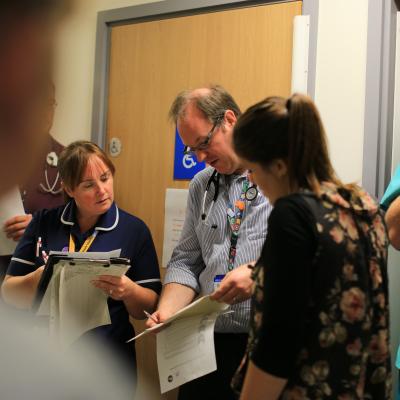Integrated care systems: what do they look like?
Integrated care systems: what do they look like?
15 June 2022

Key points
- Integrated care systems (ICSs) are the centrepiece of the biggest legislative overhaul of the NHS in a decade. From July 2022, England will be formally divided into 42 area-based ICSs, covering populations of around 500,000 to 3 million people.
- ICSs face a mammoth task. Staffing shortages in the NHS are chronic, health and care services are under extreme strain, and health inequalities are wide and growing. This long read presents analysis of publicly available data on some of the characteristics of ICSs and policy context in each area. We outline some of the challenges facing ICSs and reflect on the implications for national policy.
- The task facing ICSs is not equal. Pressures on services and the health of the population vary widely between ICSs – as do the resources available to address them. ICSs also look very different in their size, complexity and other characteristics that will shape how they function and their ability to collaborate to improve services.
- National policy on ICSs must acknowledge this variation and be realistic about what different areas can achieve. Differences in local context should be reflected in how ICS performance is assessed and reported. Policymakers must target support for ICSs with different needs, and some areas will likely require additional resources to help deliver national policy objectives.
Figure 1
Some ICSs have a high concentration of deprivation
National policymakers are emphasising the need to prioritise action on reducing inequalities. ICSs have been tasked with leading efforts to identify and reduce health inequalities in their area, alongside broad objectives to improve population health and contribute to social and economic development.11
To help guide action, NHS England has developed an approach – known as ‘Core20PLUS5’ – that focuses on reducing inequalities by targeting efforts at people living in the 20% most deprived areas (defined using the Index of Multiple Deprivation).12 Mapping how this target population is distributed between ICSs paints a stark picture (Figure 2). Less than 1% of neighbourhoods in Surrey Heartlands are in the most deprived fifth of the neighbourhoods nationally, compared with nearly 50% in Birmingham and Solihull. Wide inequalities in health outcomes between ICSs are also clear: rates of cancer mortality among those younger than 75 vary from 60 to 146 per 100,000 of the population.
Systems with similar patterns of deprivation may pursue common approaches (see Figure 2). This includes areas with a relatively high concentration of more deprived neighbourhoods (eg Greater Manchester or South Yorkshire), and those with relatively few neighbourhoods in the most deprived group (eg Hertfordshire and West Essex, or Frimley). Other areas – such as Staffordshire and Stoke-on-Trent, or Bristol, North Somerset and South Gloucestershire – have a more even spread across deprivation levels. And some have a higher proportion of neighbourhoods close to average levels of deprivation – including Somerset, and North West London. Variation within areas is also significant.13
Previous versions of ICSs were often dominated by NHS agencies and limited in their approaches to reducing inequalities.14,15 The NHS has an important role to play in ensuring equitable access to health care services. But ICBs and other NHS agencies will need to work closely with local government and other partners to address wider factors that shape health and health inequalities, such as employment, housing, and education. Making partnerships work is challenging and depends on a mix of factors, such as governance and leadership, resources and capabilities, cultures and relationships, and more.9
Figure 2
Potentially avoidable hospital admissions vary between and within systems
Closer integration of health and social care services is a longstanding policy objective in England. A series of policy initiatives have been developed that aim to strengthen services in the community and increase focus on disease prevention – for instance, by encouraging GPs, social care, mental health services and others to provide more coordinated care outside hospitals. ICSs will now be responsible for leading integration of services for people living in their area – and local agencies will work together to develop an ‘integrated care strategy’ to guide decision making.
Integrated care is hard to define and measure – and ambitions for what it could achieve are often broad and vague. But policymakers in the NHS have typically hoped that integrating services may reduce potentially avoidable admissions to hospital. Rates of unplanned hospital admissions for people with ambulatory care sensitive conditions – such as asthma, where effective management in the community can help prevent hospital admission – vary widely between ICSs (Figure 3). So do rates of emergency admissions for people with acute conditions who would not usually require a hospital admission, as well as readmissions to hospital within 30 days of being discharged.
A mix of factors are linked to rates of potentially avoidable hospital admissions – including deprivation and other patient characteristics, access to primary and community services, continuity of care, and more.16,17,18,19 Looking at admissions across large areas like ICSs is potentially misleading and masks significant variation within areas.20,21 ICS leaders will need to understand how rates vary between much smaller areas to design and target appropriate interventions. National policymakers have identified ‘places’ as the organisational level where agencies will work together to develop new models of integrated care in the community.22 But it is not always clear what these ‘places’ look like and there are a mix of options for their development.7
Figure 3
Some systems face a bigger challenge in getting services back on track
Health and care services in England are under extreme strain. Appointments in general practice are higher than before the pandemic, but the number of permanent, fully qualified GPs has fallen since 2016.23 Urgent and emergency care is under severe stress. And the waiting list for routine hospital care has reached a record high of more than 6 million – with around 300,000 people waiting over a year.2
Recovery of elective care services is a government priority24 and – having taken on greater responsibility for managing waiting lists during the pandemic25 – ICSs will now play a leading role in addressing the backlog of elective care in an ‘inclusive’ way. National policymakers have set an ambition for systems to deliver over 10% more elective activity than before the pandemic over the course of this year, with additional funding contingent on systems meeting agreed activity targets.26
ICSs are seeking to do this from very different starting points – affected by local health needs, waiting times going into the pandemic, the unequal impact of COVID-19, and more. Estimating the true scale of the backlog in different areas is complex. For example, the number of ‘missing patients’ returning for treatment is unknown and new demand will continue to appear. But data from March 2022 show the percentage of people on waiting lists who have been waiting for routine hospital treatment for more than 1 year varies from 1% to 13% (Figure 4). Meeting national timelines for eliminating long waits is a significant ask for some areas, with just over half of those waiting more than 2 years concentrated in seven ICSs (excluding waits for specialised services attributed to NHS England).
Figure 4
Resources available to meet this challenge differ. Staff shortages are likely to be the main limiting factor and workforce capacity varies between systems (see next section). Access to independent sector providers is unequal, with access higher in more affluent areas.27 And some areas are at greater risk of missing their targets and losing out on much-needed additional funding25 – such as those in more deprived areas where activity has been more disrupted by the pandemic and slower to recover.28,29
Other factors – including the geography of the ICS and the complexity of the provider landscape within it – will also affect the ability to recover services.30 ICSs with a history of NHS providers working together to plan and deliver care – for example, through piloting acute care collaborations as part of the new care models programme31 – may have a head start in working through some of the logistical challenges involved (sharing information and aligning clinical protocols, for example).
Resources differ between ICSs
Workforce shortages in health and social care are chronic and will be a major constraint on the ability of ICSs to achieve their aims.32 Tackling the growing backlog of unmet need and long waiting lists, for instance, depends on having enough staff to increase elective activity and support patients while waiting for treatment. ICSs will take on responsibilities for workforce planning: they are expected to play a ‘critical’ role in ‘growing, developing, retaining and supporting the entire local health and care workforce’5, and must develop a local workforce plan to ensure adequate staffing in their system.33
Workforce capacity varies between ICSs. For example, the number of GPs per 100,000 weighted patients and clinicians per 100,000 people in each ICS ranges widely (Figure 5) – as does the number of hospital staff. Addressing the shortage of GPs will be critical, particularly given the growing number of people living with more complex needs, including multiple long-term conditions. But shortages in general practice are not evenly distributed, and previous analysis shows there are fewer GPs per head in more deprived areas.34 Some ICSs will also face distinct workforce supply issues, with evidence suggesting that rural areas often struggle to retain and recruit new staff.35
Figure 5
With clinical commissioning groups abolished under the new reforms, ICSs will be responsible for controlling most NHS resources, including some budgets for specialised services previously held by NHS England.36 The impact of rising inflation will be felt across the NHS, even after an additional £1.5bn was allocated to systems in May to cover higher costs.37 As a conservative estimate, government would need to top up spending by at least £2.4bn by 2024/25 to match the plans set out in the spending review in 2021.38 But the scale of the financial challenge will likely differ between systems, leaving some ICSs with a much bigger task ahead of them in delivering net financial balance in 2022/23.39,40 Systems experiencing particularly severe staff shortages, for example, may incur additional workforce costs to ensure services have the staff they need to run safely.
Further reading
Work with us
We look for talented and passionate individuals as everyone at the Health Foundation has an important role to play.
View current vacanciesThe Q community
Q is an initiative connecting people with improvement expertise across the UK.
Find out more

